Russells Viper Snake

Introduction to Russell’s Viper
General Characteristics and Anatomy
Russell’s Viper (Daboia russelii) is a prominent member of the Viperidae family known for its distinctive appearance and potent venom. This species is characterized by its stout body, a broad triangular head, and a distinctive pattern of alternating light and dark bands. Adult Russell’s Vipers can reach lengths of up to 5 feet (1.5 meters), with some individuals growing even larger.
The Role of Russell’s Viper in the Ecosystem
Russell’s Viper plays a crucial role in its ecosystem as a predator. It helps control the population of small mammals, birds, and insects, thereby maintaining the balance within its habitat. By keeping prey populations in check, it indirectly supports the health of plant communities and other wildlife.
Common Myths and Misconceptions About Russell’s Viper
- Myth 1: All Russell’s Vipers are aggressive. While Russell’s Vipers can be dangerous when threatened, they generally prefer to avoid confrontation and will often strike only when provoked.
- Myth 2: Their venom is instantly fatal. While venomous, Russell’s Viper bites are not always fatal, especially with prompt medical treatment. The severity of a bite depends on various factors, including the amount of venom injected and the health of the victim.
Species Profile
| Aspect | Details |
|---|---|
| Scientific Name | Daboia russelii |
| Physical Description | Russell’s Viper has a robust body with a broad head and a pattern of alternating bands that are light brown or yellowish with dark brown or black markings. |
| Habitat | Found in a variety of habitats including forests, grasslands, and agricultural areas. |
| Diet | Primarily feeds on small mammals, birds, and insects. |
| Behavior | Mostly terrestrial, it is often found basking in the sun or hiding under debris. It is generally nocturnal but can be active during the day. |
| Venomous or Non-Venomous | Venomous |
| Venom Type | Hemotoxin and neurotoxin. |
| Venom Effects on Prey and Human | The venom causes severe tissue damage and internal bleeding in prey and can lead to systemic effects such as shock in humans. |
| Common or Rare Species | Common in its range but encounters with humans can lead to significant medical issues. |
Habitat and Distribution
| Aspect | Details |
|---|---|
| Habitats | Found in forests, grasslands, and agricultural areas. |
| Geographical Distribution | Native to the Indian subcontinent, including India, Sri Lanka, Nepal, Bangladesh, and parts of Myanmar. |
Snake Behaviour
- Hunting and Feeding Habits: Russell’s Viper employs an ambush strategy, waiting for prey to come close before striking. It uses its heat-sensing pits to detect warm-blooded animals.
- Mating and Reproduction: Breeding typically occurs during the monsoon season. After mating, females give birth to live young, which are independent at birth.
- Defence Mechanisms: Aside from its venom, Russell’s Viper relies on its camouflage to avoid predators. Its pattern helps it blend into leaf litter and other natural surroundings.
Venomous vs. Non-Venomous Snakes
- How to Identify Venomous Snakes: Russell’s Viper can be identified by its distinct banding pattern, triangular head, and stout body. It is important to note that not all venomous snakes exhibit these traits, so local knowledge and field guides are essential.
- The Purpose and Effects of Snake Venom: Venom serves to immobilize and digest prey. In humans, it can cause severe pain, tissue damage, and systemic effects if not treated promptly.
- First Aid and Medical Treatment for Snake Bites: Immediate first aid includes immobilizing the bitten limb and seeking medical attention. Antivenom and supportive care are crucial for treating severe envenomations.
Global Impact of Russell’s Viper Bites
Russell’s Viper (Daboia russelii) is a highly dangerous snake due to its potent venom, and it is responsible for a significant number of snakebite cases globally. The exact number of deaths attributable to Russell’s Viper bites varies annually and across different regions, but it is recognized as one of the most medically important snakes due to its high venom toxicity and wide distribution.
Global Impact of Russell’s Viper Bites
- Annual Fatalities
- Estimates: Russell’s Viper is responsible for a substantial portion of the estimated 50,000 to 100,000 snakebite fatalities that occur worldwide each year. This range reflects the broader category of venomous snakebites and includes contributions from various species.
- Regional Statistics: In countries such as India, where Russell’s Viper is prevalent, it is a major contributor to the annual snakebite death toll. The species is involved in a significant percentage of the approximately 20,000 to 30,000 annual snakebite deaths reported in India.
- Geographical Distribution and Incidence
- South Asia: Russell’s Viper is widely distributed across South Asia, including India, Sri Lanka, Nepal, Bangladesh, and Myanmar. In these regions, the snake’s bites are a critical public health issue due to the high population density and limited access to medical care in rural areas.
- Southeast Asia: The snake’s range also extends into parts of Southeast Asia, where it poses similar risks. Although exact figures may vary, the impact on local populations is significant.
- Medical and Public Health Impact
- Venom Effects: The venom of Russell’s Viper is hemotoxic, causing severe hemorrhage and blood clotting disorders, which can lead to systemic shock and death if untreated.
- Healthcare Challenges: Many deaths are preventable with timely medical intervention, including the administration of antivenom. However, delays in seeking treatment, inadequate medical facilities, and the high cost of antivenom contribute to the fatality rate.
- Efforts to Mitigate the Impact
- Antivenom Production: Increased production and distribution of antivenom are critical in reducing the number of deaths. Various organizations and governments are working to enhance the availability of effective treatments.
- Public Awareness and Education: Improving public awareness about snakebite prevention, first aid, and the importance of seeking prompt medical care can significantly reduce mortality rates.
Russell’s Viper is a major contributor to snakebite fatalities worldwide, particularly in South and Southeast Asia. Efforts to mitigate its impact include enhancing medical treatment availability and raising public awareness about prevention and treatment.
Conservation and Protection
- Threats to Snake Populations: Habitat loss due to agriculture and urbanization, poaching, and climate change are significant threats to Russell’s Viper populations.
- Conservation Efforts and Success Stories: Conservation initiatives include habitat protection and anti-poaching measures. Education programs aim to reduce human-snake conflict and increase awareness about the importance of snakes in ecosystems.
- How Readers Can Contribute: Support conservation organizations, participate in local wildlife protection efforts, and educate others about the ecological role of snakes.
Cultural Significance and History
- Snakes in Mythology and Religion: In various cultures, Russell’s Viper and other snakes are often featured in mythology and religious symbolism, representing both danger and transformation.
- Historical Interactions Between Humans and Snakes: Historically, snakes like Russell’s Viper have been both revered and feared, leading to varied cultural practices and beliefs about their role in human society.
Tips for Snake Enthusiasts
- How to Safely Observe Snakes in the Wild: Use binoculars to observe from a distance, avoid approaching or handling snakes, and wear protective clothing if hiking in snake habitats.
- Tips for Aspiring Herpetologists: Gain experience through fieldwork, study herpetology academically, and connect with local herpetology groups to further your knowledge and skills.
Related Information About snakes
| Topic | Link |
|---|---|
| Cobra Snake: All Information | Cobra Snake: All Information |
| The Big Four Snakes of India | The Big Four Snakes of India |
| The Deadliest Venom | The Deadliest Venom |
| Most Dangerous Snakes in the World | Most Dangerous Snakes in the World |
| The Ultimate Guide to Snakes | The Ultimate Guide to Snakes |
| History of Snakes: Evolution, Habitats, and Survival | History of Snakes: Evolution, Habitats, and Survival |
FAQ: Russell’s Viper
What is Russell’s Viper?
Russell’s Viper (Daboia russelii) is a venomous snake native to the Indian subcontinent. It is known for its distinctive appearance, which includes a robust body and a pattern of alternating light and dark bands. The snake is recognized for its potent venom and significant role in local ecosystems.
Where can Russell’s Viper be found?
Russell’s Viper inhabits a variety of environments, including forests, grasslands, and agricultural areas. It is distributed across the Indian subcontinent, with its range extending through India, Sri Lanka, Nepal, Bangladesh, and parts of Myanmar.
How does Russell’s Viper behave?
Russell’s Viper is primarily terrestrial and often found basking in the sun or hiding under debris. It is generally nocturnal but can also be active during the day. The snake employs an ambush strategy for hunting, using its heat-sensing pits to detect warm-blooded prey.
What does Russell’s Viper eat?
Russell’s Viper feeds on a range of small animals, including mammals, birds, and insects. Its diet plays a crucial role in controlling local populations of these prey species.
Is Russell’s Viper venomous?
Yes, Russell’s Viper is venomous. Its venom contains both hemotoxins and neurotoxins, which can cause severe tissue damage, internal bleeding, and systemic effects in humans. Prompt medical treatment is essential in the event of a bite.
If bitten by a Russell’s Viper?
If bitten by a Russell’s Viper, it is crucial to seek immediate medical attention. First aid measures include immobilizing the bitten limb and avoiding movement. Antivenom and supportive care are necessary for treating severe envenomations.
How can I identify Russell’s Viper?
Russell’s Viper can be identified by its distinct banding pattern, triangular head, and stout body. The snake’s light and dark banding helps it blend into its environment. However, not all venomous snakes have these features, so local expertise and field guides are important for accurate identification.
What threats does Russell’s Viper face?
Russell’s Viper faces threats from habitat loss due to agriculture and urbanization, poaching, and climate change. These factors contribute to population declines and increased human-snake conflicts.
What conservation efforts are in place for Russell’s Viper?
Conservation efforts for Russell’s Viper include habitat protection, anti-poaching measures, and educational programs aimed at reducing human-snake conflict. These initiatives help safeguard the species and promote awareness of its ecological role.
What cultural significance does Russell’s Viper have?
Russell’s Viper holds cultural significance in various regions, often featured in mythology and religious symbolism. It represents both danger and transformation, reflecting the complex relationship between humans and snakes.
How can I safely observe Russell’s Viper in the wild?
To safely observe Russell’s Viper, use binoculars to watch from a distance, avoid approaching or handling the snake, and wear protective clothing if exploring its habitat. Understanding the snake’s behavior and habitat can enhance safety and minimize risks.
What should aspiring herpetologists know about studying Russell’s Viper?
Aspiring herpetologists should gain field experience, study herpetology academically, and connect with local herpetology groups. This knowledge and experience are valuable for understanding and conserving species like Russell’s Viper.
-
The Neem Tree – Nature’s Green Treasure
The Neem tree (Azadirachta indica) is one of the most remarkable and beneficial trees found in India and many tropical countries around the world. Known as the “Village Pharmacy” or “Nature’s Gift to Mankind,” Neem is celebrated for its medicinal properties, environmental benefits, and cultural significance. At WildlifeNest.com, we bring you a deep dive into…
-
The Unsung Heroes of Wildlife Habitats
The Unsung Heroes of Wildlife Habitats Introduction Plants are the foundation of every thriving ecosystem—they provide food, shelter, and the very oxygen we breathe. At Wildlife Nest, exploring how flora supports wildlife is vital for building awareness and appreciation for our natural world. Why Plants Matter for Wildlife Types of Wildlife-Friendly Plants Plant Type Benefits…
-
Types of Grass – A Complete Guide
Grass is one of the most common and important plant types on Earth. It plays a key role in agriculture, landscaping, sports fields, lawns, and wildlife habitats. There are thousands Types of Grass Species found around the world, each with unique features and uses. Major Categories of Grass Grasses are usually divided into two main…



